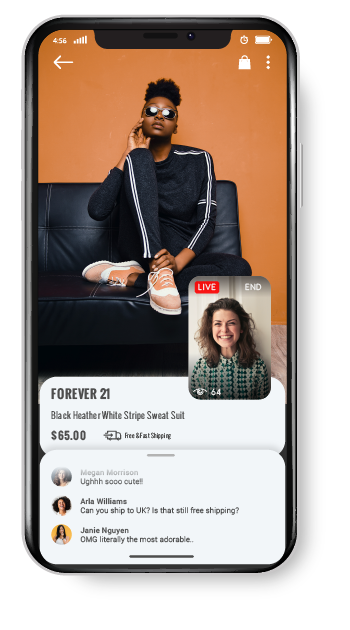Live Commerce: How Streaming Is Transforming Shopping (Update)
January 14, 2021
Live commerce, a term used to describe the combination of streaming video and e-commerce, promises to revolutionize the retail industry and consumer shopping habits. Here’s a rundown of how live commerce is taking shape, trends in the retail space, and our predictions for what’s next.
The Evolving Retail Industry
Brick-and-mortar stores have been shutting their doors for some time. But with the COVID-19 pandemic, store closures went into hyperdrive. More than 8,000 retail locations closed down for good in 2020, confirming that ‘business as usual’ is no longer an option.
Today, chatbots and mobile apps make online customer support seamless. Machine learning technologies provide the personalized recommendations that we’ve all come to expect. And overnight delivery is commonplace.
E-commerce has already transformed everyday life. And even as lockdowns ease, the physical mall will continue to crumble. But some aspects of the in-store experience go missing when shopping in the digital world.
Shopping has traditionally been a sensory experience. Sight, touch, sound, smell, and taste all prove useful when evaluating an item for purchase. That’s why Costco doles out free samples, and car lots allow buyers to test-drive prospective vehicles.
Now that online has become the predominant place for consumers to research goods and services, retailers are struggling to replicate these material aspects of shopping. It’s no secret that buying online yields convenience. But what about engagement? Will a visit to Amazon.com ever be as fun as a trip to Rodeo Drive?
Cue in live commerce. By fusing online retail with live streaming, today’s companies are attempting to bring consumers one step closer to the in-person experience.
Types of Live Commerce
Just as online shopping transformed retail twenty years ago, live streaming promises to transform e-commerce today. Dubbed live commerce, this convergence of video and shopping helps improve engagement, close the gap between customer and product, drive sales, and — in cases where bidding is involved — increase the average sales price.
Let’s take a look at some of the most common formats for live shoppable media.
Online Marketplaces
Online marketplaces ranging from Alibaba to eBay allow users to buy and sell products without ever leaving their homes. But the addition of live video streaming is proving vital to keeping buyers interested. Why? The ability to purchase online is no longer a novelty. Without new layers of engagement, online marketplaces will become a thing of the past.
By integrating live streaming into the platform, these marketplaces can deliver the closest possible experience to ‘being there’ for those tuning in from their living room. Real-time interactivity replicates the urgency of a real marketplace, prompting immediate action and enhanced community participation.
Live Auctions
Live video streaming is bringing 18th-century auction houses like Sotheby’s and Christie’s into the 2020s. By enriching their digital presence, these organizations are connecting bidders worldwide with the excitement of the saleroom. Live streaming opens up the bidding pool to those unable to physically attend, reaching participants with varying interests and ensuring that each item sells at its proper valuation.
Online auctions are big business, and real-time video delivery is critical. Whether auctioning off livestock or fine art, any delay in a live stream could prevent bids from being recorded properly. Fractions of seconds can translate to billions of dollars in lost revenue when deploying these formats online.
Get the low latency streaming guide
Understand the critical capabilities required to provide interactive live streaming experiences.
Download FreeInfluencer Streaming
Today’s celebrities aren’t necessarily on the big screen. Reality TV put media personalities like Kylie Jenner on the map, and an increasing number of stars rise to fame via social media each day. This has, in turn, opened up new revenue opportunities.
With an already captive audience, influencers can use their personal brand and the power of live streaming to promote their favorite products in an interactive format. Influencer streaming originated on social media, but has now become commonplace across e-commerce sites as well. The format converts younger demographics at the highest rate. While only 26% of the general populations’ purchase decisions are based on social influencers’ recommendations, the same is true for 44% of Gen Z’s.
Live Events
There’s plenty of overlap between live events and the categories described above. Still, newsworthy events such as product launches, limited edition drops, and retail holidays like Singles Day or Black Friday lend incredibly well to shoppable live broadcasts.
Kohl’s was an early adapter of live commerce by streaming the LC Lauren Conrad Runway show during the 2015 New York Fashion Week. Delivered via Periscope, viewers had the option to purchase any garments seen on the catwalk via a dedicated portal. Today, shoppable mobile streaming allows fans to purchase items in real time from the catwalks of Louis Vuitton and Victoria’s Secret.

Live Commerce in China
To understand live commerce, the first place to look is China — where it’s projected to soon become a trillion-yuan ($157.50 billion) market. Shoppable video was alive and well in China before the pandemic, but sheltering in place quickly translated to a COVID-19 boom. According to the government, more than 10 million live commerce streams were hosted in the first six months of 2020.
Taobao — the world’s biggest e-commerce website — empowers farmers, business owners, and self-employed entrepreneurs with consumer-to-consumer live streaming. The Alibaba-owned platform is the eighth most visited site in the world. As a close rival, JD.com also makes it easy for anyone watching a live stream to add items to their cart with just a click.
Successful influencers on the platforms ascend to celebrity-like status, helping elevate the shopping experience from mundane to swanky. And just like at a Nordstrom beauty counter, consumers can ask questions and learn application techniques.

Beyond just generating fans, the top sellers bring home serious bucks. Star saleswoman Viya Huang sold over $45 million worth of goods on Single’s Day in 2019. Even more impressive, on a record-high night early last year, she attracted more viewers to her online shopping channel than the Game of Thrones finale.
Changing Dynamics Across Every Industry
Jewelry, fashion, accessories, and skincare all dominate Taobao and JD Live. But since the pandemic hit, traditionally offline industries such as home appliances and cars have also found traction within the app. Even rural farmers are embracing live streaming to promote goods ranging from rice to fresh fish.
“Growers who had once sold 90% of their products offline have now flipped to selling 90% online,” writes MIT Technology Review’s Karen Hao. “Live streaming has not only helped the industry weather the crisis—it’s forged an entirely new way of business that is likely to continue long after the pandemic is over.
Both Taobao and JD.com continue to enrich the live experience by adding augmented reality, 3D animations, and enhanced personalization. In July of last year, a live event on Taobao attracted 2.7 million viewers, signifying continued growth for this trend in the post-coronavirus world.
Other streaming services in China are adapting to get into the live commerce game. The e-commerce platform Vip.com and short video app Douyin (the Chinese version of TikTok) are leveraging live streaming to power their retail businesses.
Live Commerce in Korea and Across Asia Pacific (APAC)
Hot on China’s heels, South Korea also has stake in the live-commerce game. LF Corp combines live streaming with real-time chat and one-click purchases to create seamless shopping experiences. This has resulted in a 30% year-over-year increase since 2015.
Then there’s TMON (formerly Ticket Monster), a Korean subsidiary of Groupon. Whereas LF Corp specializes in clothing sales, TMON commands the product, grocery, and travel verticals. By bringing a wide range of shopping experiences to mobile devices, TMON has grown its sales revenue exponentially over the past five years.
The role that live streaming plays in these APAC countries can’t be overemphasized. More than 100 million viewers in China watch a live online video event every month. Revenue from the online-video market was projected to surge from $3.5 billion to $17.6 billion between 2015 and 2020.
South Korea and China are growing faster than any other country in the Asian live-stream market, with the average growth across this area (which includes China, India, Indonesia, Japan, Malaysia, the Philippines, Singapore, South Korea, Taiwan, Thailand, and Vietnam) forecast at a compound annual growth rate (CAGR) of 46.4 percent.
Live Commerce in the USA
Western entrepreneurs have lagged behind when it comes to the fusion of tech and retail that we now call live commerce.
JTV (Jewelry Television) pioneered shoppable video in the U.S. ten years ago by moving from a restrictive cable model that limited its audience to those on specific cable plans to an internet distribution model allowing for global viewership. This, in turn, attracted a younger demographic to their channels. Even so, JTV remained one of the few retailers to harness the power of streaming for quite some time.
Although certainly late to the party, Amazon launched Amazon Live in 2019. Think Home Shopping Network goes digital, with the addition of icons fluttering on the screen each time a purchase is made. Models try on different outfits while hosts describe the material and fit, guest presenters demonstrate how to use various tools, and the top five toys are showcased for viewers.
Several startups like Dote — branded as ‘Gen Z’s dream mall’ — also tried to get in on the trend. But American consumers weren’t embracing live commerce with the same level of enthusiasm that’s been observed in the APAC region.

And Then, COVID-19 Hit
Live stream shopping is now booming in the U.S. as more people eschew physical stores. Online has become one of the only places for retailers to connect with customers. And even as lockdowns ease, the physical mall will continue to crumble.
Instagram introduced Live Shopping in the second half of 2020, and Facebook began experimenting with Facebook Shops. Walmart, Google’s Shoploop, and Shopify all joined the party, giving users the chance to buy items featured on live streams via a seamless UX. Plenty of VC-backed companies like NTWRK, Popshop Live, ShopShops, and Moda Operandi also launched while the deadly virus spread.
“COVID-19 really forced retailers out of their comfort zone and to think out of the box. With stores shut, retailers had to find new ways to connect, not just with existing e-commerce consumers, which they already had, but to convert and meaningfully engage those consumers who were used to shopping in-store.”
Saisangeeth Daswani, fashion advisor at Stylus
To reach everyone reluctant to venture into a high-risk shopping center during the 2020 holiday season, Walmart teamed up with TikTok to host a one-hour shoppable event. Influencers used their clout to demo items for purchase, and the app made it seamless for viewers to purchase an item quickly. Soon though, even micro-sellers will leverage in-app purchase capabilities to get in on the action.
What’s Next for Live Commerce
COVID or no COVID, brick-and-mortar retail was clinging to an outdated model. But this doesn’t mean that retailers should abandon every aspect of the in-person experience.
When live commerce is done correctly, gamification and real-time interactivity help drive consumer interest. Immersive 3D experiences using virtual reality (VR) can also help engage remote users — allowing buyers to study the clothing from every angle and experience the excitement of being in the crowd of a runway show.

Augmented reality (AR) also promises to push live commerce forward. Picture this: After purchasing a new home, you enlist the expert help of an interior designer working at your favorite home furniture store. Within an app, you’re able to show the designer the space you’re working with. Then, using augmented reality, you can try the representative’s suggested furniture on for size. Simply point your camera at the empty space, and let the app overlay an image of the couch, table, or rug you selected.
Moving Live Commerce Forward
While AR/VR technologies open up endless possibilities, innovation in live commerce leaves plenty to be desired without getting too fancy.
A new gardener might choose to visit a garden center rather than shop online out of the need to speak with someone. So why not create a solution where users can live-stream while a garden expert diagnoses whether their plants are suffering from gray mold or spider mites? By video chatting with a representative and streaming their sick plant, the buyer would be more confident about their purchase (and more likely to spend money).

Even in the pre-pandemic world, the physical mall was clinging to an outdated model.
But if there’s one thing Zappos (an early e-commerce trailblazer) taught us, it’s that customer experience matters. The retail giant got ahead by encouraging customers to order multiple sizes of the same product, and then providing a free and easy way to return whatever didn’t fit.
No, live commerce isn’t an exact replica of the in-store shopping experience. But in an economy where customer experience dictates which brands live and which brand die, why not reach shoppers on their own terms?




